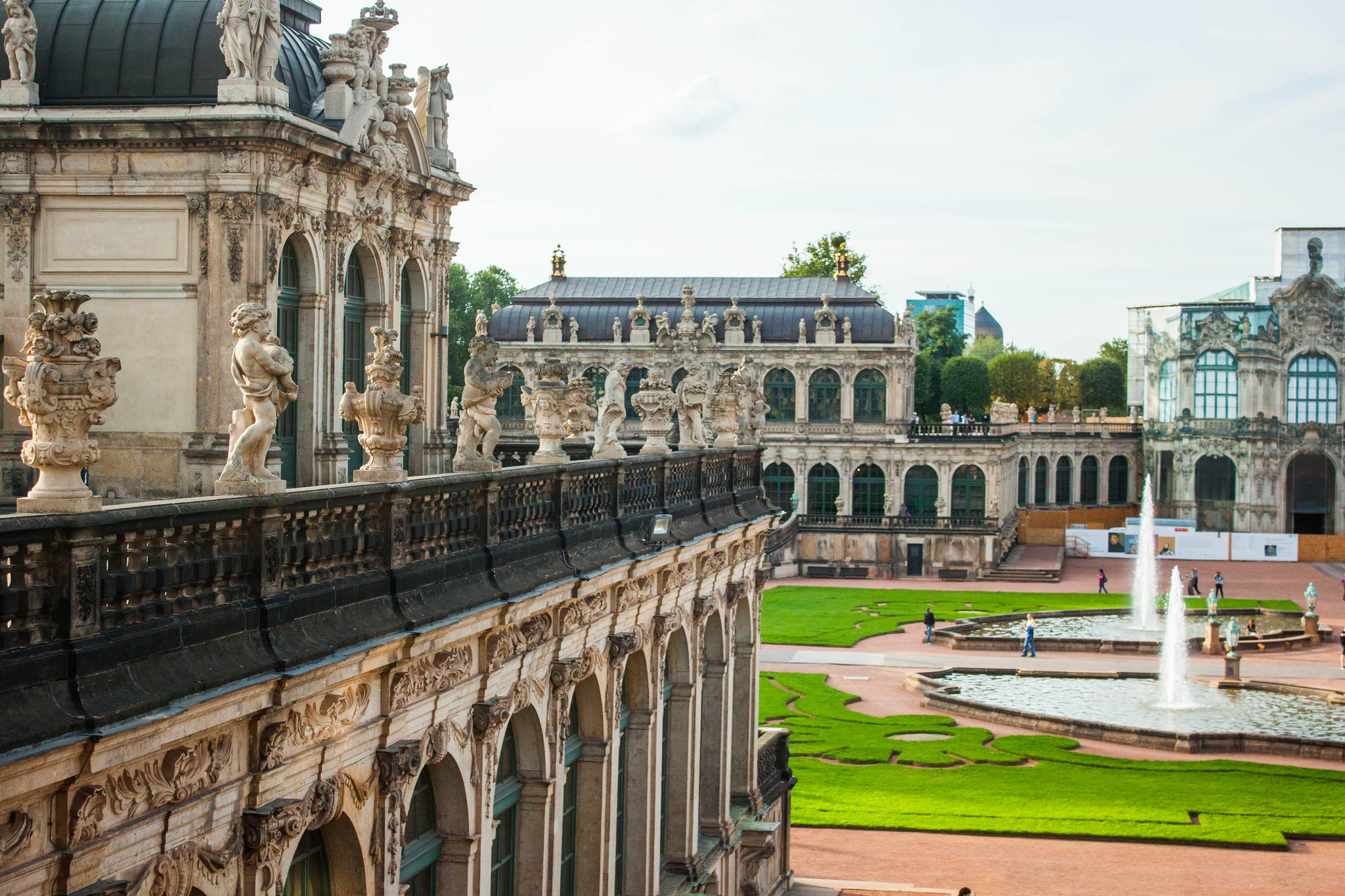Germany – Saxony (Dresden, Leipzig, Chemnitz)
GÖRLITZ (pop 56,000)
Located on the Neisse River, it is the most Silesian town in Germany in terms of character, combining both Lusatian and Sorbian cultures. It has been under the control of many German occupiers since 1031. It is across the river from Zgorzelec, Poland. Near the end of World War II, German troops destroyed all bridges crossing the Lusatian Neisse. The redrawing of boundaries in 1945—in particular the relocation of the German-Polish border to the present Oder-Neisse line—divided the town. The right bank became part of Poland and was renamed Zgorzelec by the Polish communist government in 1948, while the main portion on the left bank remained part of Germany, now within the state of Saxony. When the East German states were dissolved in 1952, Görlitz became part of the Dresden District, but the states were restored upon German reunification in 1990.
Whilst the town was well preserved, it was notably grey and colourless under communist East German rule. Since reunification, and as of 2013, over 700 buildings have been renovated. It is a popular destination for older people in Germany, offering quiet and relatively affordable accommodations by German standards. Its tourist potential is rapidly expanding. In the case of Görlitz, much of the funding for the town’s building renovations comes from an anonymous donor, who has sent an annual donation of over €500,000 since 1995, totalling over €10,000,000.
Today, Görlitz and Zgorzelec, two towns on opposite banks of the narrow river, get along well. Two bridges have been rebuilt, a bus line connects the German and Polish parts of the town, and there is a standard urban management, with annual joint sessions of both town councils.
The town has a rich architectural heritage (Gothic, Renaissance, Baroque, Neoclassical, Art Nouveau). One example of this rich architectural heritage is the Schönhof, which is one of the oldest civic Renaissance buildings in Germany. Another medieval heritage is a model of the Holy Sepulchre, which was constructed in the late 15th century.
Wow, what a gorgeous small city, obviously not impacted by WW II. It is full of 3- and 4-story adjoining houses, all painted in different lovely pastels, with dormers on their steep roofs.
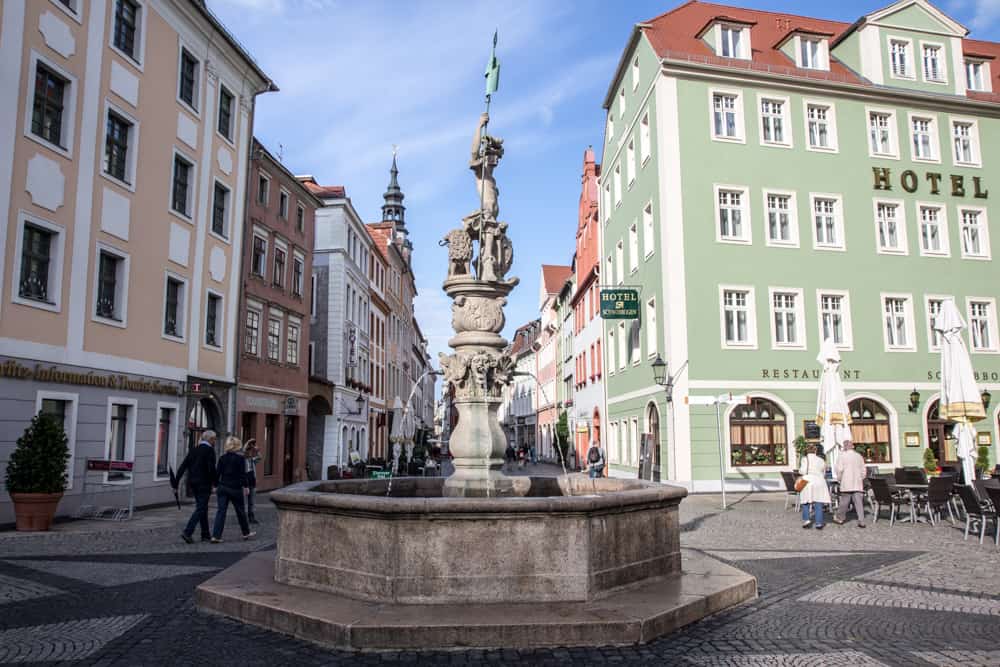
Altstadtbrücke; Görlitz/Zgorzelec. This new pedestrian bridge is a single-span metal arch that spans the Neisse River, connecting the old town of Görlitz, Germany, to the old town of Zgorzelec, Poland. The bridge is just below the church.
St Peter and Paul Church. Built as a 3-nave church in 1230, the neo-Romanesque façade was incorporated into the Gothic reconstruction in the 15th century, when two more side naves were added, making it a 5-nave church and almost square in plan. The lone stained glass window is the only survivor of the Allied bombing of the bridge below the church in 1945. The Sun Organ has the organ pipes arranged as sunbeams around small sun faces – it was reconstructed in 1995-97 with 6,095 pipes. The original two church bells, weighing over 10,850 kg, were melted down during World War I. In 1891, the concrete spires were added. Free
Cathedral of St. James (St Jakobus). The exterior of this Catholic church is interesting – all red brick with numerous buttresses and chapels jutting out, all roofed with dark brown tiles. The brick continues inside the columns, ribs of the vaults, and around the windows (clear yellow/white surrounded by coloured glass frames) and confessionals. All have green brick accents.
I was all alone in this church except for a young girl learning processional rituals.
Villa Schminke, Löbau. The Haus Schminke by Hans Scharoun is one of four outstanding examples of the styles “New Architecture” and “International style” (architecture). It is in each of the architectural encyclopedias and mentioned within the same breath as the Villa Tugendhat by Mies van der Rohe in Bruenn/Brno, Czech Republic (1931), The Villa Savoye by Le Corbusier in Poissy, near Paris, France (1928 – 1929) and the House Kaufmann, Fallingwater by Frank Lloyd Wright, Mill Run, Pennsylvania, USA (1935 – 1939).
In 1930, Hans Scharoun designed the house for Fritz Schminke, the owner of a noodles factory in Loebau, Saxony, Germany, who wished for “…a modern home for two parents, four children, and one or two occasional guests…”. The realization was both fanciful and functionally adequate. A curved main body, terraces, outside stairs and numerous round, porthole-shaped windows inspire the connotation of a steamship. Rooms merge seamlessly; generous grasslands extend the garden as an integral part of the living space. Besides span and lucency, manifold design elements contribute to the overall spatial experience. Developed especially for the house, their colours and shapes set outstanding courses. In contrast, utility rooms, including a Frankfurt kitchen, and the sleeping area remain sparse by design, featuring easy-to-clean surfaces and space-saving built-in closets.
In 1945, the Russian Red Army confiscated the house, and it became a Soviet Army military commander’s office. The Schminkes regained the house in 1946, but at the same time, Fritz was expropriated from his Anker pasta factory. Then, his wife Charlotte established a children’s recreation home for the families of bomb victims to make a living. Her husband returned from Russian war captivity in 1948 and left the former GDR in 1950. He was regarded as a war criminal for being a supplier to the German Army Wehrmacht during World War II His wife followed him, and both of them lived in Celle, Lower Saxony, in 1951. In 1963, it became the “Haus der Pioniere” (“House for the Pioneers”), the former official communist organization for children until German reunification. The city of Loebau established a leisure center for teenagers in 1990. It was in 1993 when the Schminke family renounced their house’s back transfer for the benefit of public use.
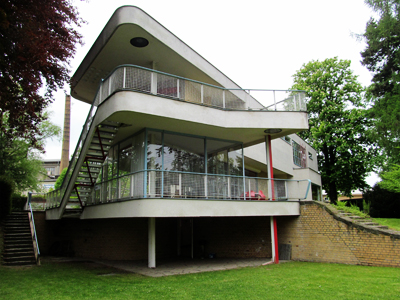
Cathedral of St Peter, Bautzen. The first church was built in the 10th century, and a cathedral was constructed in the 13th century. Between 1456 and 1463, the cathedral that now stands was built and named after St. Peter. A fourth nave was added to the original structure. After a fire in 1634, the interior is seen today. The church is a mixture of several different architectural styles, the most prominent being Gothic and Baroque. The Baroque dome was added to the tower in 1664.
Since 1530, both Catholics and Lutherans have shared the building. In 1980, St. Peter’s became the co-cathedral with Trinity Cathedral in Dresden.
SAXON SWITZERLAND NATIONAL PARK (Sächsische Schweiz National Park)
In the Elbe Sandstone Mountains 30 km southeast of Dresden, this is Saxony’s only national park. It occupies 92 km² in the 93 km region between Pirna and the Czech border. The tributaries of the Elbe River have cut narrow gorges through the table mountains, creating strangely eroded rock formations, sandstone cliffs, and other unique geological features. The park features 700 rock climbs, 400 km of hiking trails, and 400 km of cycle routes, along with numerous vantage points offering panoramic views.
Most people view the park as part of a day trip from Dresden, often arriving by boat via the Elbe. Or you can base yourself in Pirna, Obervogelgesand or Bad Schandau. There is no official entry point, and it can be accessed on all paths.
Kirnitzschtal tramway, Bad Schandau. This is the Sächsische Schweiz National Park’s two-car electric tram, which runs 7.1 kilometres from the resort town of Bad Schandau to the last stop at Lichtenhainer Wasserfall. The track is on the south side of the road, following the small Kirnitzsch stream. It is flat and located in the forest, with limited views. There are seven stops, each giving access to trails, and with pubs and inns at most stops. €4
Konigstein Fortress, Konigstein. Above the town of Königstein on a table hill on the left bank of the River Elbe, it is one of the most extensive hilltop fortifications in Europe. The 9.5-hectare rock plateau rises 240 metres above the Elbe and has over 50 buildings, some over 400 years old, that bear witness to the military and civilian life in the fortress. The rampart run of the fortress is 1,800 metres long, with walls up to 42 metres high and steep sandstone faces.
A stone castle likely existed on Königstein as early as the 12th century. The oldest surviving structure today is the castle chapel built at the turn of the 13th century. In the years 1563 to 1569, the 152.5 metre deep well was bored into the rock within the castle, the deepest in Saxony and the second deepest well in Europe.
The fortress played an essential role in the History of Saxony as its actual military significance was rather marginal. The Saxon Dukes and Prince-Electors used the fortress primarily as a secure refuge during times of war, as a hunting lodge and maison de plaisance, but also as a dreaded state prison.
The fortress was tasked with guarding the Saxon state reserves and secret archives during times of war. In 1756 and 1813, Dresden’s art treasures were also stored at Königstein. During the Second World War, the large casemates of the fortress were also used for such purposes. The fortress was never conquered. Only the chimney sweep, Sebastian Abratzky, managed to climb the vertical sandstone walls in 1848. The Abratzky Chimney is a Grade IV climbing route that remains climbable to this day. Because climbing over the wall is banned, climbers must abseil down the adjacent wall again after climbing it. The fortress, which has been used as a state prison for centuries, remains intact and is now one of Saxony’s most prominent tourist attractions, attracting around 700,000 visitors annually.
This is a very imposing fortress sitting high above the village of Königstein. From the north, the main access is marked by a massive stone wall that extends up from the contours of an immense rock face. Take a toy train or bus from the parking area up to the bottom of the wall and the fortress.
The inside has several buildings and castles. The most imposing is George’s Castle with a great bastion, striking defences, and the Commander’s House. There are several exhibits in the Commander’s House Stable, Treasury House, Gate House, Magdalene’s Castle, Well House, and Garrison Church. Woods have taken over the south end of the fortress, and this part of the fortress is only visitable by guided tour.
A wooden crane on the outside of the wall, operated by a pedal wheel, was installed in 1592 to take goods 42m to the top of the fortress. In 1852, power was generated by a steam engine, and by 1911, it was generated by electricity. However, all of this was removed in 1992. A Panorama Lift was installed in 2005 but remained non-operational. Access to the fortress is via a goods lift located at the base of the wall. €12, no reduction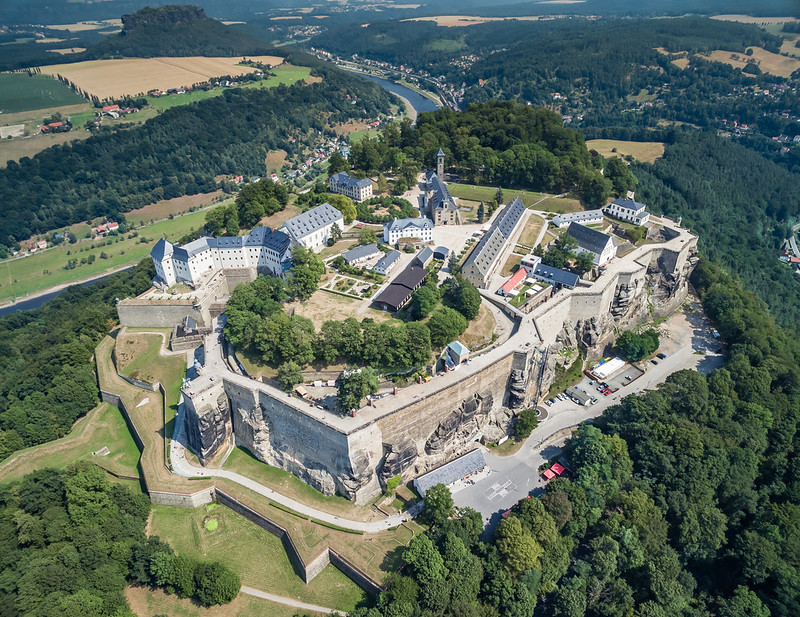
BASTEIBRÜCKE (Bastei Bridge), Rathen. Part of the national park, this is an odd place to find. The 2km long entrance road to Rathen has no sign for Bastei, just many hotels and almost no parking. The only parking is well above the town. Most people arrive here by boat from Dresden. The city fronts the Elbe River.
In the village, arrive at a pedestrianized zone and park (I slept here overnight and found a place at a hotel, but during the day, it would be impossible). The signs at the bottom are also somewhat confusing, as they are in German, and none mention “Bastei,” instead leading up a cobbled road to the south. I left in the dark at 6 am.
75m up the road, the path takes off to the left. It is a steady climb through woods to the top of the crest with two excellent viewpoints down to the Elbe and the town across the river.
The sandstone formations are eroded pinnacles with round tops and form a long ridge. Maleweg Route (Painter’s Way) is one of the most popular hiking routes in the park. It starts in Rathen (about a 15 km drive from Bad Schandau) as the access trail to the bridge, crosses the bridge and heads south – Steinerner Tisch 20 minutes, Stadt Wehlen 1¼ hours, Hollengrind and Lohmen 1¾ hours.
Felsenburg Neurathen. Pass the castle just before you reach the bridge. In a completely impossible location, it was built in 1289 by Bohemian nobility to protect their borders. In 1466, bandits controlled it, in 1467, it was besieged by Saxony and burned down in 1469. All that remains is the courtyard, cistern, and traces of rooms with placements cut for the wooden beams and bridges that connected all the pinnacles. However, it is well worth exploring for its location and 120m of parapet crossing several pinnacles, which offer fantastic views of the bridge, down into the canyon, and to all the surrounding mountains and pinnacles. A small compass sign names every bump and mountain in the near and far vicinity. The two most prominent are Napoleonsschanze (1813m) and Lilienstein across the river. €2
Bastei Bridge. This is a stone/concrete pedestrian bridge built in 1850-51 with five arches and six piers fixed to pinnacles. It was an enjoyable 30-minute walk from Rathen. A trail to the best viewpoint takes off from the Maleweg. The place was packed with photographers. Sunrise was at 6:31, about one minute after I arrived, but the sun soon disappeared behind clouds. 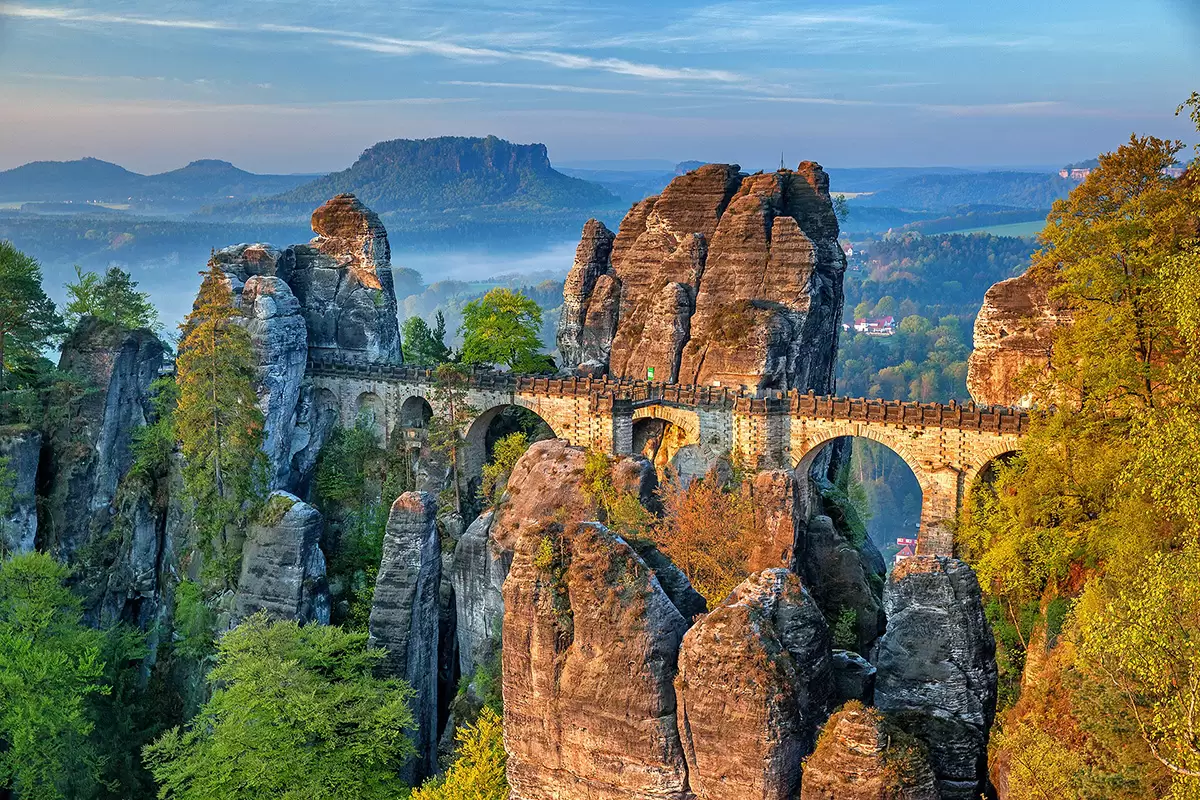
DRESDEN (pop 550,000)
Dresden is the second-largest city on the River Elbe, after Hamburg. Most of Dresden’s population lives in the Elbe Valley. The name of the city, as well as the names of most of its boroughs and rivers, are of Slavic origin, and the Sorbian language area begins east of the town, in Lusatia.
Dresden has a long history as the capital and royal residence for the Electors and Kings of Saxony, who for centuries furnished the city with cultural and artistic splendour. The city was known as the Jewel Box due to its baroque and rococo city center. The controversial American and British bombing of Dresden in World War II, towards the end of the war, killed approximately 25,000 people, many of whom were civilians, and destroyed the entire city centre after the war, restoration work has helped to reconstruct parts of the historic inner city, including the Katholische Hofkirche, the Zwinger and the famous Semper Oper.
Since German reunification in 1990, Dresden has again become a cultural, educational, and political centre of Germany and Europe. The economy of Dresden and its agglomeration is one of the most dynamic in Germany, dominated by high-tech branches, often referred to as “Silicon Saxony”. The city is also one of the most visited in Germany, with 4.3 million overnight stays per year. The royal buildings are among the most impressive buildings in Europe. Main sights aiclude the nearby National Park of Saxon Switzerland, the Ore Mountains, and the countryside around theElbe Valley and Moritzburg Castle.—te most prominent building in the city isthe Frauenkirche. Built in the 18th century, the church was destroyed during World War II. The remaining ruins were left fas a war memorial for 50 years efore being rebuilt between 1994 and 2005.
Dresden Museum Card. Their museum pass has some unusual features: it is sold by the day, so the onset is not timed with the first museum entry; if purchased online, the voucher must be printed out (I told them I don’t carry a printer in my suitcase); and it is only available as a 2-day pass. Choice of adding public transportation. But a good deal as €22 for two days.
Pilnitz Castle. Built on the Elbe River in 1707 by Augustus the Strong for his mistress, the Countess of Cosel, later additions included the orangery and the English and Chinese pavilions. In 1768, the palace complex became a summer residence for the Saxon royal family.
The famous gardens feature a 250-year-old camellia tree and are surrounded by the U-shape of the Hillside Palace, the New Palace, and the Riverside Palace, each of which has a museum. The palaces have painted facades and under eaves. The park is open from 6 am to twilight. On the side of the Riverside Palace, above the curved steps leading down to the river, are marked the levels of 18 floods recorded since 1784, with the highest occurring in 1845 and 2002, both of which exceed the lowest floor of the palace (the top of the steps is 6.75m above the standard river level). Most occurred in February, March, and April, but the 2002 flood was in August. €8, 4 with Dresden Card.
Schwebebahn Dresden (Dresden Funicular).
Albrechtsberg Palace. Prince Albert of Prussia married Rosalie von Rauch of the Netherlands, which was against Prussian law; as a result, his bride was banned from the court. So he built this castle in Dresden (outside of Prussia) between 1850 and 1854.
All marble, gilt, exotic wallpaper, decorated ceilings, chandeliers, and wood, with few furnishings, it is pretty over the top. €8
Frauenkirche. With a light cream exterior completely dominated by the giant dome, the Baroque interior is lovely, featuring a triple-level curving balcony in pastel green, blue, and red, capitals with angels, a light green marble altar covered in gilt, and statues topped by the organ. The dome has eight murals and a balcony.

Albertinum. 3rd floor – German artists of the 1800s, then some Impressionists, and then early 1900s. I enjoyed many of the artworks. 2nd – predominantly sculpture, including their archive vault. 1st floor – a vast entrance hall featuring a sculpture and their archive. €12
STAATLICHE KUNSTAMMLUNGEN DRESDEN
Dresden Castle. These museums are located within the Dresden Castle. The outer wall is a fantastic picture, depicting kings and soldiers along its entire length.

Procession of Princes
The castle had the following three museums, plus what is next:
Prints, drawings, and photographs on the 3rd floor, mostly by Rembrandt, but also by Picasso and many others. Coin Cabinet on the 2nd floor. King’s Room (Furstengalerie) on the 1st floor.
Turkish Chamber. 5 centuries of Ottoman art – swords, horse trappings, saddles, tents. This is included in the SK museum.
Dresden Armoury. Almost all of it is dress armour and weapons used for parades and jousting tournaments; then the armour is used by the guard. Amazingly decorative armour, especially on the horses. On the 1st and 2nd floors.
Grünes Gewölbe
New Green Vaults, Incredible goblets, vessels, miniatures (cherry stones very unusual, ivory), caskets, cabinets, turned ivory vessels, jewellery, clocks. Room after room of the most fantastic stuff; it got so overwhelming that I finally had to leave. Finish with the 41-carat Dresden green diamond (formed when the diamond is exposed to radiation) set in a medallion with hundreds of other diamonds.
Only the New was included in the Dresden card on the 1st floor.
The Old Green Vault is a restored Baroque room in the palace, featuring free-standing art and artwork on the walls.
The Zwinger. This enormous palace also has several museums. Porcelain, including one all on Meissen, with 80 of the several hundred full-size porcelain animals made by Meissen. They were scared to glaze and fire them a second time due to the high likelihood of cracking, so they painted them and covered this with a lacquer. Unfortunately, this had not weathered well, and all the large animals were white. But many birds were full colour.
It is possible to walk around the entire palace on the roof. The parapet is adorned with hundreds of sculptures. Fountains pour off the sides of the buildings. The center features a grass area cut into elaborate designs, with four separate pools and fountains located in the centre.
Gemäldegallerie Alte Meister. In the Zwinger, it was under reconstruction, and there is only a small gallery with the highlight paintings.
Museum of Saxon Folk Art. This folk art museum boasts thousands of remarkable items: 1st floor – painted chests, wardrobes, homemade furniture, dollhouses, ceramic stoves, dishes, and light fixtures. 3rd floor – towns, villages, armies, coal mines. 2nd floor – puppets (most with carved wood faces and heads), traditional dress, fairs, mechanical towns, mechanical towers, biblical scenes. Zero English. €5
World of the GDR. Different from the Berlin GDR museum (which had a lot of explanations of the system and was very interactive), this one displayed many products, especially cars, electronics, and household goods. €5, 3.50 with Dresden card
BOT Botanical Garden. Although a little disorderly, it was nicely organized by area. Many small greenhouses – I especially liked the cacti/succulents with many giant cacti, especially from NA, and all the orchids. Free
St. Simeon of the Wonderful Mountain Church (Russisch Orthodoxe Kirche Dresden). Dark inside, it was very peaceful and smelled lovely. I was alone and sat for a few minutes just soaking in the ambience. The highlight is the altar, all white marble with carved columns and tented tops. There were only a few icons, all the usual, with the Last Supper in the center. The most cherished icon is a small St Simeon in the center. Free. German Hygiene Museum. I don’t think the German translation of what we understand of hygiene is the same. This museum has nothing to do with cleanliness, but it’s really about our bodies, medicine and health. Some of the permanent exhibits are “The Human Adventure” (the human body, transparent man, living and dying, the mind, beauty, skin, and hair) and “The Five Senses”. The temporary exhibit was titled “Plants and People.” €9. 8.10 reduced with Dresden card
UFA-Palast. In the NM “Modern Architecture Buildings” series, this cinema features a reinforced concrete side that supports the cinema and a large front lobby with inclined glass. I wanted to watch a movie, but they didn’t have any in English, so they referred me across the street to another cinema that frequently showed English movies.
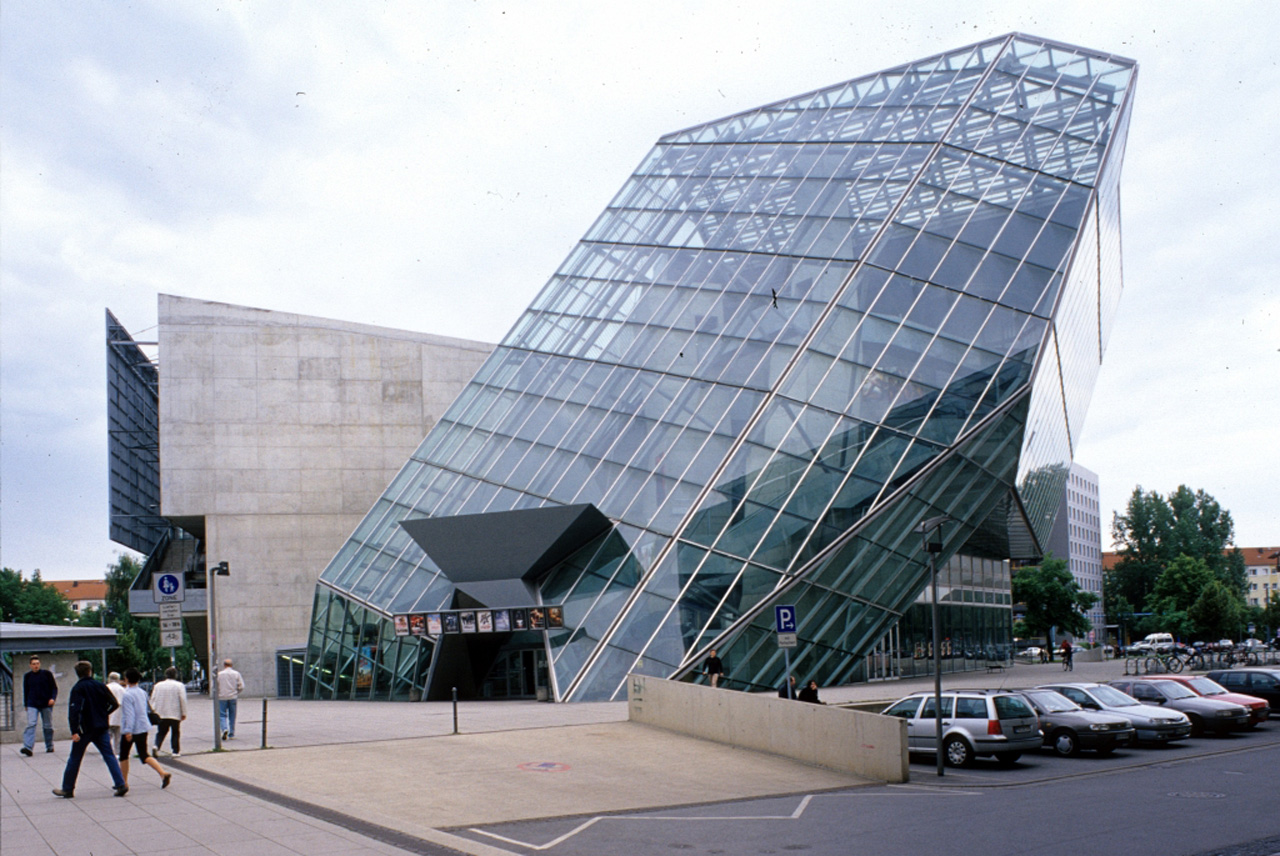
CHEMNITZ
Located in the Ore Mountain Basin, the city is surrounded by the Ore Mountains to the south and the Central Saxon Hill Country to the north on the Chemnitz River (progression: Zwickauer Mulde→ Mulde→ Elbe→ North Sea).
By the early 19th century, Chemnitz had become an industrial centre (sometimes called “the Saxon Manchester”). In 1913, Chemnitz had a population of 320,000, and, like Leipzig and Dresden, it was larger at that time than it is today. After losing inhabitants due to the First World War, Chemnitz experienced rapid growth and reached its all-time peak of 360,250 inhabitants in 1930. Allied bombing destroyed 41 per cent of the built-up area of Chemnitz during the Second World War. Chemnitz contained factories that produced military hardware and a Flossenbürg forced labour subcamp (500 female inmates). The oil refinery was a target for bombers during the Oil Campaign of World War II.
Following the reunification of Germany in 1990, many residents of Chemnitz migrated to the former West Germany, and unemployment in the region increased significantly. Additionally, Chemnitz lacked adequate shopping facilities, but large shopping centers were constructed on the city’s periphery in the early 1990s. Chemnitz is the only major German city whose centre was re-planned after 1990.
Saxon Railway Museum. In two round houses and a prominent museum building, several locomotives, including the most interesting of the original high-speed trains, are on display. €4
Chemnitz Center. This older shopping mall is unusual in that it spans several buildings, but is otherwise unremarkable, featuring all the usual stores.
Wechselburg Priory, Wechselburg. It features lovely stuccoed siding and two balconies adorned with faux marble. The most interesting are the ancient, well-worn pews.
LEIPZIG (pop 588,000)
Leipzig is located about 160 kilometres southwest of Berlin at the confluence of the White Elster River (progression: Saale→ Elbe→ North Sea) and two of its tributaries. The name of the city, as well as the names of many of its boroughs, are of Slavic origin.
Leipzig has been a trade city since at least the time of the Holy Roman Empire. The city sits at the intersection of the Via Regia and the Via Imperii, two important medieval trade routes. Leipzig was once oa major European center of learning and culture, particularly n fields such as music and publishing. Leipzig became a major urban center within the German Democratic Republic (East Germany). Events in Leipzig in 1989 played a significant role in precipitating the fall of communism in Central and Eastern Europe, mainly through demonstrations.
Leipzig today is an economic centre, one of the most livable cities in Germany. Leipzig has long been a major center for music, encompassing both classical and modern genres, including darkwave. Johann Sebastian Bach is one of many major composers who worked and lived in Leipzig.
Alte Messe. This market in south Leipzig operates on weekends.
Russian Memorial Church. With gilt angels on the façade, the interior is quite stunning. With a towering, steep “dome”, the highlight is the large iconoclast – 58 icons, each separated by gilt columns and each row by carved wood, and then the gilt/silver, jewelled and enamelled doors and icons on the bottom in heavy silver and gilt jackets. Brass plaques and a crest highlight the front and walls.
A plaque on the front commemorates those who fought and died in the 1813 Battle of Leipzig against Napoleon: Russian (127,000, 22,000), Prussian (72,000, 16,000), Austrian (89,000, 12,000), and Swedish (18,000, 300).
Botanical Garden. Run by the University of Leipzig, this is another wonderful garden featuring numerous rock gardens and rock borders surrounding the beds. Zero English. Free, €4 to enter the greenhouses.
Monument to the Battle of Nations
Forum 1813 – Museum zur Völkerschlacht bei Leipzig.
Museum of City History Leipzig. €6, no reduction
Forum of Contemporary History. The history after 1945 (see Potsdam Conference) and the formation of the GDR. In 1945, all banks were nationalized, land was nationalized and redistributed to small landholders, and elections were rigged. This is my 3rd GDR museum, and they all give more info that adds to the perspective. 3rd floor photos and cartoons, but no English. Free
Bach-Museum. €8
Quatrier M. In the NM “Modern Architecture Buildings”, this 5-story apartment building is pastel cream with tan/pink trim. Two windows are just off the second floor, and balconies are on top of two apartments. The 5th floor has only a dormer window in the roof line. An upscale market/restaurant occupies the bottom. The flats can’t be entered.
